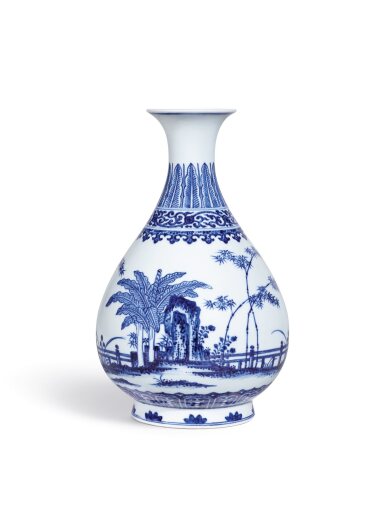
Property from an Important Collection | 顯赫收藏
A fine and rare blue and white vase, yuhuchunping, Seal mark and period of Qianlong | 清乾隆 青花竹石芭蕉紋玉壺春瓶 《大清乾隆年製》款
Auction Closed
October 9, 10:57 AM GMT
Estimate
3,000,000 - 5,000,000 HKD
Lot Details
Description
Property from an Important Collection
A fine and rare blue and white vase, yuhuchunping,
Seal mark and period of Qianlong
顯赫收藏
清乾隆 青花竹石芭蕉紋玉壺春瓶
《大清乾隆年製》款
28.9 cm
Tianminlou Collection, acquired in Hong Kong in 1986.
天民樓,1986年購於香港
Chinese Porcelain in the S.C. Ko Tianminlou Collection, Hong Kong Museum of Art, Hong Kong, 1987, cat. no. 62.
Blue and White Porcelain from the Tianminlou Collection, Chang Foundation, Taipei, 1992, cat. no. 87.
Tianminlou qinghua ci tezhan [Special Exhibition of Blue and White Porcelain from the Tianminlou Collection], Shanghai Museum, Shanghai, 1996, cat. no. 93.
《天民樓藏瓷》,香港藝術館,香港,1987年,編號62
《天民樓青花瓷特展》,鴻禧美術館,台北,1992年,編號87
《天民樓青花瓷特展》,上海博物館,上海,1996年,編號93
Expertly crafted with an elegant round body tapering to a flared neck, this vase epitomises the height of early Qing porcelain production at Jingdezhen, when craftsmen strived to design innovative wares as well as recreate historical masterpieces that acted as reminders of China’s glorious past. Such developments were realised by the hands of highly skilled and creative potters under the instruction of talented superintendents, such as Tang Ying (1682-1756) who was active at Jingdezhen in the Yongzheng and early Qianlong reigns. Equally crucial was the early Qing Emperors’ eagerness to revive the celebrated porcelain tradition as a means to legitimise their right to rule.
From the Yongzheng reign, treasured antiquities were sent to the Imperial kilns at Jingdezhen to be copied and the Qianlong Emperor increased such commissions. Underglaze blue porcelains of the early Ming dynasty were particularly appreciated, as evidenced in Tang Ying’s record of official porcelain from 1732, which lists copies both of Yongle and Xuande blue and white wares. While the auspicious motif on this vase first appeared in the Hongwu reign, it is most likely that the Qing version was based on a Yongle prototype, such as a vase in the Palace Museum, Beijing, illustrated in The Complete Collection of Treasures of the Palace Museum. Blue and White Porcelain with Underglaze Red (I), Hong Kong, 2000, pl. 33. The arrangement of flowers and rocks, the depiction of lappets and the scroll band at the neck, as well as the small lotus flowers at the foot are very similar.
Scenes of sophisticated gardens with fantastic rocks, bamboo, banana trees and other plants began to be painted on blue and white porcelain during the Yuan dynasty, where the motif proved most popular among a Middle Eastern audience who was attracted by the exotic nature of these plants. In the Ming dynasty, the design took a highly symbolic character and embodied the qualities and virtues of the scholar. Bamboo symbolises longevity, endurance and loyalty, as it remains green in winter and does not break in the wind. Rocks symbolise durability and steadfastness and are associated with reliability and friendship. Plantain leaves on the other hand, are one of the fourteen treasures of the scholar and represent education and self-cultivation. Banana leaves were used for practicing calligraphy by famous historical figures and poets, including Huaisu (c. 735-c.799). The Qianlong Emperor himself is portrayed writing on a banana leaf as Prince Hongli in the anonymous painting Prince Hongli Practicing Calligraphy on a Banana Leaf, in the Palace Museum, Beijing, included in the exhibition China: The Tree Emperors 1662-1795, Royal Academy of Arts, London, 2005, cat. no. 187.
A closely related vase in the National Palace Museum, Taipei, is illustrated in Porcelain of the National Palace Museum. Blue and White Wares of the Ch’ing Dynasty, vol. II, Hong Kong, 1968, pl. 12; one in the Palace Museum, Beijing, is illustrated in Zhongguo taoci quanji [Complete series on Chinese ceramics], vol. 15, Shanghai, 2000, pl. 12; another was sold in our New York rooms, 20th March 1976, lot 174, and again at Christie’s New York, 17th September 2008, lot 459; and a fourth example was sold Christie’s Hong Kong, 30th May 2006, lot 1410, and again in these rooms, 8th October 2010, lot 2773.
Vases of this design were made from the Yongzheng reign through the Xuantong period; a closely related vase is illustrated together with examples from the Yongzheng, Daoguang, Xianfeng and Tongzhi reigns in the Shanghai Museum in Lu Minghua, Qingdai Yongzheng – Xuantong guanyao ciqi [Qing dynasty official wares from the Yongzheng to the Xuantong reigns], Shanghai, 2014, pls 3-107 and 3-32.
玉壺春口沿微撇、頸細而腹碩,器型雅緻,為清代景德鎮典範之作,彼時製瓷工藝之純熟,由此可見一斑。能工者既摹古創新,雙管齊下,彰顯中國輝煌歷史。此般功績,非技藝高超、思維廣散之巧匠而不能就;還歸功於督陶官之朝督暮責,唐英便為其一,任職於雍正與乾隆早年期間,天賦異禀、瓷藝卓絕。同時,清初統治者急欲借復興瓷業之舉以匡正其統治,宣揚聖威,亦視為關鍵因素。
雍正時期,皇帝便時常傳旨運送歷代佳瓷至景德鎮御窰廠,著其照樣燒造,至乾隆朝,此舉愈興。據唐英所紀官窰事宜,明初青花器備受清廷眷睞,自雍正十年(1732年)起,仿永、宣二朝之佳品迭出。竹石芭蕉圖玉壺春瓶始燒於洪武朝,然清代仿製品之形制更近永窰器,不論花、石樣式,頸部蕉葉紋及卷草紋之描繪,或是圈足點綴之蓮瓣紋,均甚為相似,可見北京故宮所藏一作例,圖刊於《故宮博物院藏文物珍品全集.青花釉裏紅(上)》,香港,2000年,圖版33。
繪庭院小景題材之青花器,始見於元,繪欄柵、洞石,配修竹、芭蕉等,清麗風雅,別開生面。此番中式景緻,饒有本土意境,尤投中東諸國所好,喜其異國情調。明朝圖樣設計,多以物喻人,寄興寓情。竹,冬寒而常青,風饕愈凌然,素托以長壽、堅韌、忠貞之品質。石質堅,象徵隱忍、剛毅之性情,又可表牢靠之關係、友誼。蕉能代紙,為文人十四寶之一,以其借喻學識淵博、品行高遠之士。文人墨客以蕉代紙,揮毫撒墨,於其上習字題詩,古有懷素「蕉書」之韻事。佚名宮廷畫師曾作一幅四阿哥弘曆蕉書圖,現藏北京故宮博物院,展於《盛世華章》,皇家藝術學院,倫敦,2005年,編號187。
台北故宮博物院藏一類例,圖見《故宮藏瓷.清青花瓷》,卷2,香港,1968年,圖版12。北京故宮博物院亦存一例,著錄於《中國陶瓷全集》,卷15,上海,2000年,圖版12。另一相若例,售於紐約蘇富比1976年3月20日,編號174,後又於紐約佳士得2008年9月17日易手,編號459。再比較一例,兩度售於香港佳士得,分別為2006年5月30日,編號1410,及2010年10月8日,編號2773。
竹石芭蕉圖玉壺春瓶自雍正至宣統均有燒造,上海博物館現藏雍正、乾隆、道光、咸豐及同治五朝作例,可資比較,圖見陸明華,《清代雍正.宣統官窰瓷器》,上海,2014年,圖版3-107及3-32。
You May Also Like





